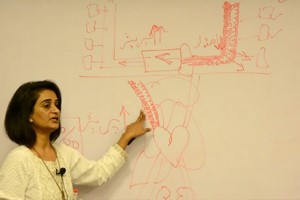Use of active illustration in patient education
This story is written by Ms. Nausheen Salim, Senior Instructor, School of Nursing And Midwifery, Karachi.
"Although I am a nurse by profession, I value my identity as a teacher. Teaching nurses in a clinical setting provides them with important on-site hands-on experience of patient care. One important clinical skill that I teach nurses is patient education. This involves educating patients to help them understand “what has happened to them,” “what are the possible causes,” “how can it be treated,” and “what is the future plan for care.”

“Active Illustration Technique” is a useful tool to use with patients and their families to inform them about their disease process and to help them make decisions about their proposed plan of care. By using the scientific knowledge base, effective communication skills, and simple metaphorical exemplars, a nurse can help the patient understand the medical diagnosis. For example, the metaphor of blocked water pipes is used to generate discussion about the risk factors, pathophysiology, signs and symptoms, and complication of high blood pressure.
To use active illustration technique, one needs to think of various life processes and compare them with real-life phenomena existing in society. This also involves thinking about how the disease could adversely affect life processes. After choosing the metaphor from daily life, one illustrates the process using stick-figure drawings while conversing with the patient. To use this strategy, one only needs to have an A4-sized paper and a pencil.
There are two pre-requisites for successful use of this strategy: knowing the language of the patient and complete knowledge of the disease process under discussion. However, this strategy may not work in certain circumstances, for instance, if a patient is not interested or ready to hear the details of his/her disease or he/she is not in a state of mind to comprehend the issue.
My students use a variety of exemplars and metaphors in educating their patients about the health problems they are experiencing. Students report that “this technique enhances patients’ understanding of their conditions.” Consequently, “it enhances their competence in implementing any proposed plan of care.” They also find it “useful in developing a rapport with the patients and their families.” In addition, it develops a “sense of trust and mutual respect between patients and student nurses.” This is beneficial for patient compliance with treatment and post-treatment care. Also, this technique could lead patients’ improved satisfaction for the care provided, a better understanding of the role of nurses, and the enhancement of nurses’ self-worth.
In conclusion, I think this strategy is applicable to most disciplines in general and nursing education in particular. Using on-the-spot narration of the phenomenon at hand, using metaphors and visual illustrations, and engaging learners’ multiple senses can lead to a better understanding of how complicated medical knowledge can be effectively transferred."


